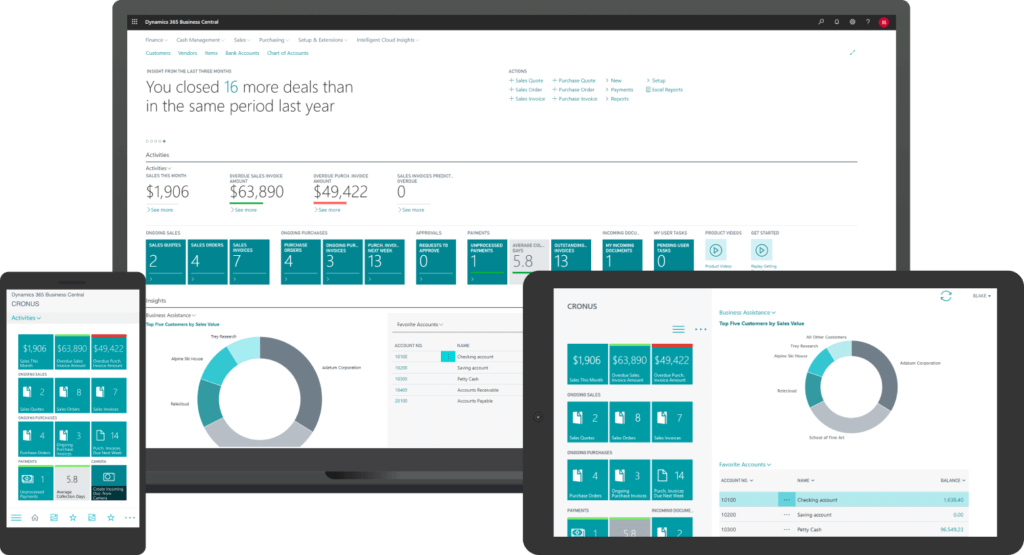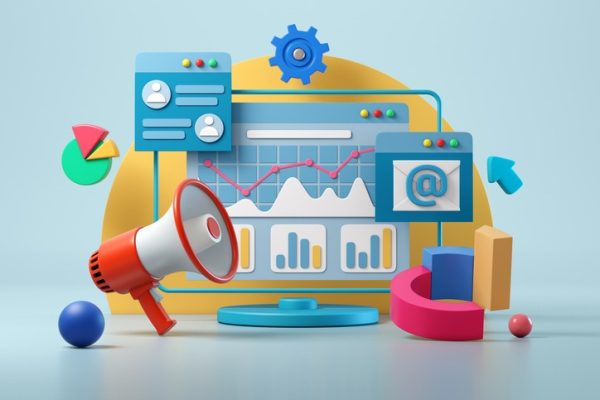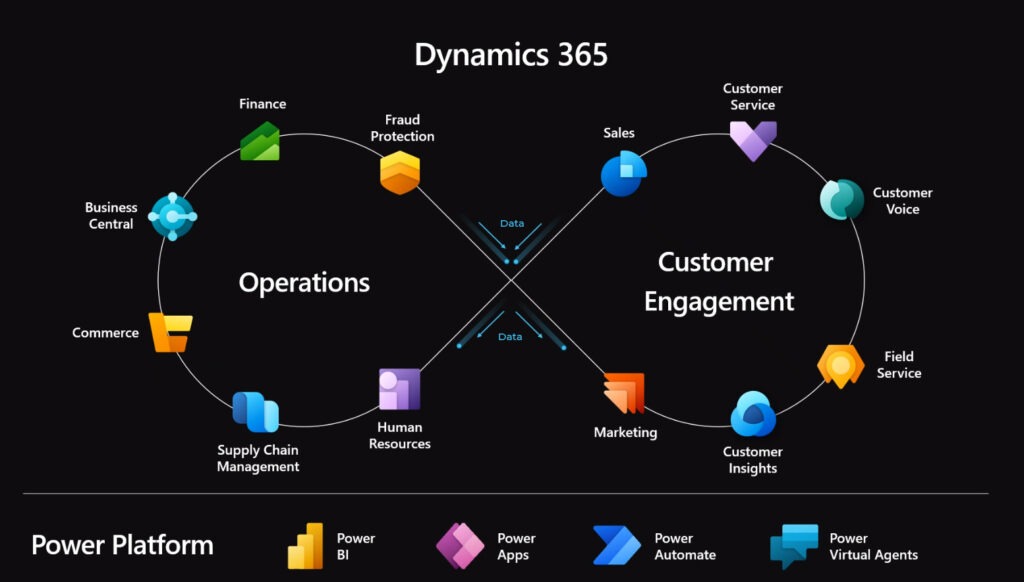Which are the functions of an ERP and CRM?
Both implementations, ERP and CRM, seek to adapt the company to the digital transformation, improving productivity, control and efficiency, but their areas of action are different.
A combination of management applications with ERP and CRM capabilities, integrated with key tools for collaboration and communication, office automation, data analysis, and artificial intelligence that are adjusted and customised according to the needs and complexity of each business and sector.
Which are the functions of an ERP and CRM?
Both implementations, ERP and CRM, seek to adapt the company to the digital transformation, improving productivity, control and efficiency, but their areas of action are different.

Enterprise Resource Planning – ERP
A company’s back office
An ERP is a “back office” software, for internal use and procedures that do not have a direct impact on the relationship with customers. An ERP works on the exchange of information between departments and the control of these departments, helping to reduce production costs, a control of stock and storage, a supervision of sales (not in the management of sales, but for example to see which products are the best sellers), a control of invoices and an administration of accounting or payroll.
What company doesn’t need an ERP?
An ERP manages a large part of a company’s internal processes
For example, giving inputs to the production department about the best-selling products and at the same time sharing information with the financial department about costs, profits, etc. Basically, an ERP, which is usually a modular tool, acts on the following dimensions of a company: Production, Payroll, Sales control, Stock control, Accounting and finance, Supply and suppliers.
communication is everything

The ultimate goal of an ERP is to centralise the integral management of a company in one tool, aiming for better interdepartmental communication and better access to data.
now let’s see what CRM is for
Customer Relationship Management – CRM
A company’s “front office”
Having reviewed ERP, it is now the turn of CRM. A software that is also considered a “front office” as it is a tool that does affect customer relations and external processes.
The purpose of CRM is to organise customer information, to put it at the centre of the company, to help in the management or commercial follow-up and to be able to draw up strategies for both, sales and marketing.
organisation matters most

Most valuable leads. Archive not only sales but also loyalty
Unlike an ERP, CRM contains customer information, making it a more dynamic and agile tool in terms of use, implementation, learning and functionalities.
CRM stands for a business model that seeks to identify the most valuable leads for the company and to manage their relationships in an efficient and decisive way in order to achieve not only sales but also loyalty.
A satisfied customer is a loyal customer
Functions of a CRM and what can be expected from it
• Automation of sales processes, from lead registration, lead follow-up, alert system or task management.
• Storing and managing customer information such as emails, posts, interactions with the company, meetings, attribution sources, etc.
• Creation of segments for different marketing or sales objectives, such as strategy planning, communications segmentation, sales forecasting, buyer person construction, etc.
• Commercial follow-up and creation of processes in the same
the power in your hands!


More effective marketing campaigns. Minimise costs
The implementation of a CRM is essential to carry out a refined and accurate marketing as, in a context such as the current one, promotional or communication actions must be segmented as much as possible to increase conversion rates and minimise costs per lead and per customer.
let’s boost sales!
CRM is customer-centric software whose purpose is to improve the customer’s relationship with the company (both before and after the sale) and to increase sales. And in this case, unlike ERP, CRM is useful in all types of companies because no company can afford to do without sales.
all where you need it!


The heart of Dynamics 365 is the apps and the so-called “Power Platform”
All of this creates an environment in which data analysis, communications, management applications (economic-financial, purchasing and sales, manufacturing, warehouse, marketing, customer service, service projects, HR/talent management) and office applications securely and fluidly exchange information (Excel, Word, Outlook, OneDrive, OneNote, Teams, Power BI, Forms, etc).
In many cases, this will be the ultimate goal of the digital transformation strategy of a large number of organisations, mainly small and medium-sized companies.
everything comes alive
Dynamics 365, artificial intelligence and mixed reality
Dynamics 365 can go much further and incorporate extremely sophisticated features based on artificial intelligence (AI) and mixed reality add-ons. In these advanced scenarios, increasingly common in large organisations, the capabilities of Dynamics 365 applications are enriched with additional layers of artificial intelligence provided by Microsoft Dynamics 365 AI (Sales Insights, Customer Insights and Customer Service Insights) that provide resources to obtain predictive insights, take action and improve the customer experience.
are you enjoying the content? Share and like it!

Any interaction will count and will be used with Dynamics
• Sales Insights, among other uses, it can detect new professional relationships (third-degree contacts) from introductions obtained through first-degree contacts; analyse the sentiment and tone of conversations; prioritise potential customers and opportunities that have the highest probability of conversion and purchase; receive recommendations and suggestions as notes are written, based on the context.
• Service Insights, uses information extracted from case resolution, pending case trends and historical comparisons to assess customer service agent performance and business impact through dashboards with integrated AI, business intelligence and machine learning capabilities.
let’s take a look at virtual reality…


Projects with mixed reality components are themselves an area of innovation
These highly complex integrations combine Dynamics 365 applications with tools that enable the simultaneous intervention (Dynamics 365 Remote Assist) of several service agents from different locations around the world; Collaboratively design and review projects (Dynamics 365 Layout); Design, customise and visualise products virtually (Dynamics 365 Product Visualize) or deploy mixed reality tools for simulated virtual learning (Dynamics 365 Guides).
all the tools you need
Dynamics 365, is just a business management software in the cloud?
No. Microsoft allows its customers to choose where to deploy their software. There are some options:
• Deployments in on-premise environments (local environments).
• Cloud deployments, either in private or public cloud (SaaS).
• Scenarios in which a hybrid model operates (part of the infrastructure in on-premise spaces and part in the cloud). However, for technical reasons, some of the functionalities of Dynamics 365 applications are only available in the cloud.
it’s not for lack of options


What is the Power Platform on Dynamics 365?
It is a set of tools that, interconnected through a common data model, enable the secure flow of information collected in Dynamics 365, Power BI, Power Apps and Microsoft Flow applications.
to make things even easier
What does the Microsoft Power Platform achieve?
• Work with a single platform of connected applications.
• Enrich Dynamics 365 applications with large customisations and custom developments.
• Build lightweight, low-code applications with great agility and versatility.
• Obtain insights (indicators and trends) from data, no matter where they are.
• Ensure the security and proper management of business data.
If you like the content, please like and share it !